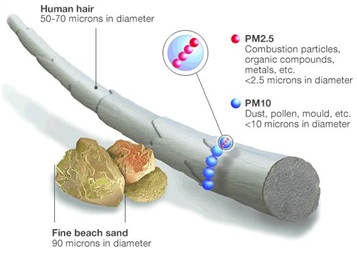

Context
Every year, the residents of India's capital region and surrounding areas experience hazardous levels of air pollution at the beginning of winter. Smoke from stubble burning in the adjoining farmland areas of the states of Haryana and Punjab, as well as fumes from vehicles and industry, enshroud the city as lower temperatures and slower-moving winds trap pollutants in the air.
Analysis
Who is responsible for the pollution?
- Contributing to nearly 30 percent of winter air pollutionin Delhi, stubble burning across the nearby states of Punjab, Haryana, and Uttar Pradesh is attributed as one of the major factors for the existence and amplification of air pollution in the region during the winter period.
- Farm fires have been an easy way to get rid of paddy stubble quickly and at a low cost for several years.
- The paddy straw and stalks have high silica content and are not used to feed livestock. The easiest, but the least productive, way to get rid of it is to set it on fire.
What other reasons are responsible?
- Dust and vehicular pollution: Dust and vehicular pollution are the two biggest causes of dipping air quality in Delhi in winters. Dry cold weather means dust is prevalent in the entire region, which does not see many rainy days between October and June.
- Geography: Disadvantaged geographic location and regional meteorology with windy and dusty conditions during summer contributes greatly to Delhi's air pollution. Low relative humidity further increases particle re-suspension.
- Overpopulation: Over-population only adds up to the various types of pollution, whether it is air pollution or noise pollution.
- Stagnant winds: Due to winter conditions, dust particles and pollutants in the air become unable to move. Stagnant winds lock these pollutants in the air and affect weather conditions, resulting in smog.
- Large-scale construction is another culprit.
- Industrial pollution and garbage dumps increase air pollution and building-up smog in the air.
- Crackers (banned): Crackers contributed to smog’s build-up.
|
Winter inversion
Note: The effects of inversion are stronger at night, which is why air quality levels drop overnight. (This is why experts ask people to refrain from early morning walks) |
How bad is air pollution in Delhi?
- Atmospheric levels of harmful small particles which can be inhaled - known as 5 - are currently far above international guidelines set by the World Health Organization (WHO).
- The toxic soup over north India is composed of several types of pollutants such as sulfur dioxide (SO2), nitrogen dioxide (NO2), PM2.5, PM10, and Ozone.
- The most harmful ones are PM2.5 and NO2.
- NO2 (sources): Emission by vehicles and power plants
- 5 (source): industries, vehicles, power plants, crop and garbage burning, and diesel generators
- Health Impacts: The health impact of these pollutants can range from
- asthma
- cancer
- strokes
- Alzheimer’s disease

WHO’s limits for air pollution
The World Health Organization has cut its recommended limits for air pollution, for the first time since 2005. The new recommendations target pollutants including particulate matter and nitrogen dioxide, both of which are found in fossil fuel emissions.
- NO2:The new limit for nitrogen dioxide (NO2), mainly produced by diesel engines, is now 75% lower.
- PM 2.5:Under the new guidelines, the WHO halved the recommended limit for the average annual PM2.5 level from 10 micrograms per cubic meter to 5.
- PM 10:It also lowered the recommended limit for PM10 from 20 micrograms to 15.
These guidelines are not legally binding.
|
WHO’s 2005 guideline
|
Government initiatives to safeguard the environment
- Graded Response Action Plan: Delhi launched a ‘Graded Response Action Plan’ under directions from the Supreme Court.
- NCAP: Launched in 2019, the National Clean Air Programme (NCAP) aimed at a long-term, time-bound, national-level strategy to tackle the air pollution problem across the country in a comprehensive manner with targets to achieve a 20 percent to 30 percent reduction in particulate matter concentrations by 2024, keeping 2017 as the base year.
- Green Skill Development program: Launched in 2017 by the Ministry of Environment, Forest, and Climate Change under PM Narendra Modi, the Green Skill Development program aims to introduce innovative skills among the youth working in the environment and forest sector.
- Compensatory Afforestation Fund Act (CAMPA): One of the most robust legal acts aiming to hold those, who exploit natural resources and forests for the development of industries, responsible. The Compensatory Afforestation Fund Act was introduced in 2016.
- Namami Gange program: In 2014, PM Narendra Modi, considering the environmental value of the river Ganga, launched the Namami Gange program. The Centre allocated a total of Rs 20,000 crore to conserve and rejuvenate the river.
- Nagar Van Scheme: Nagar Van Scheme was launched on the occasion of World Environment Day in 2020 (5th June). It aims to develop 200 Urban Forests across the country in the next five years.
Environmental Management in India
- The Indian Parliament has enacted several laws to protect and improve the environment.
- Wildlife (Protection) Act, 1972
- Water (prevention and control of pollution) Act, 1974
- The forest (Conservation) Act, 1989
- The air (prevention and control of pollution) Act,1981
- The Environment (Protection) Act, 1986
- In addition the Constitution (forty-two amendments) of the Act, 1976 included two important provisions namely.
- Article 48-A
- Article 51A (g)
|
Right to a clean environment
|
Conclusion:
The situation needs better coordination between states, and afterward, city and regional-level pollution control plans need to be drawn up. Not only Delhi, but other states also need to get more serious and not treat high levels of pollution as a normal part of winter.

